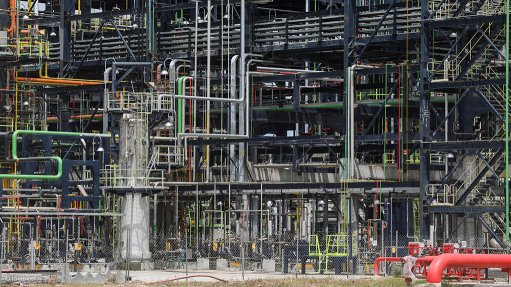Mega engineering projects could boost SA economy
As South Africa is embarking on a mega railway infrastructure development that will take an estimated 20 years to complete, transportation systems developer Futran Group of Companies director Andries Louw says such projects should be used as an anchor to re-establish the culture of mega engineering project excellence in the country, but that this will require “exceptional” political will and drive.
Futran is a system of transportation where people and goods are moved on automated pods along the same guideway. In 2016, it started deploying the first client systems in South Africa and, currently, the company is designing systems for clients in countries across Africa.
“In the rest of Africa, the majority of these types of projects are now funded and deployed by the Chinese government using Chinese skills and Chinese technology
. . . it now seems increasingly likely that South Africa will follow this model to the detriment of our own capacity to undertake these types of projects,” laments Louw.
He illustrates this concern by citing the Moloto Rail Corridor project, with media reports having indicated that government allegedly awarded the tender for the project to Chinese parastatal China Communications Construction Company for R57-billion – three times the estimated value of the project just two years ago.
He explains that, with the locally developed Futran Public Transport System, the Moloto Rail Corridor project could cost far less than R10-billion, using local skills and expertise, as well as local steel and locally manufactured components.
“The same accounts for the Passenger Rail Agency of South Africa’s (PRASA’s) modernisation programme, where the parastatal intends on spending R170-billion, most of it on imported goods and skills, whereas we can build and deploy superior systems to what PRASA currently has for about 20% of this cost. We may soon export the best the world has to offer from South Africa to the rest of Africa, while we import redundant, overpriced, inferior rail systems from abroad,” Louw tells Engineering News.
The Futran Public Transport System is the public transportation system of choice in many African cities using existing right-of-way corridors such as sidewalks of roads or railway line reserves. At about R20-million a kilometer for a double track that can transport as many as 50 000 people per hour in each direction, the capital cost of the system is relatively low, and by using steel wheels on a steel track with an electric motor, little maintenance is required.
Louw says the company has received signs of support from several South African cities to develop a Futran Public Transport System and they are looking forward to the first development of a Futran Public Transportation System in the country.
He says the company expects to announce the award of the first South African-based project to be developed in December or early next year.
Louw says, for as little as R5 a person a trip, using Futran, people can be transported from Soweto to Sandton in less than 15 minutes while the system runs at a profit and requires no State subsidisation.
He is adamant that the Futran System is the most cost effective, reliable, efficient and user-friendly public transportation system in the world. “It will not only help Africa meet its transportation and mobility challenges but also completely transform our understanding of mobility and what is possible.”
When asked how the company has integrated new technology into the system, Louw says passengers can use mobile phones similar to, for example, an Uber application.
“The user will receive a notification to be at the Futran station at a specific door at a specific time, for example, five minutes from the time he/she made the booking. Should a passenger miss the timing, the system will pick up from the GPS tracker on the person’s phone that the user is not at the station yet, and simply reschedule the pod for later when the user is there – on- demand public transportation as opposed to on schedule public transportation.”
However, Louw says the real challenge is integrating the booking and payment systems of different transport modes so that one ticket is purchased, even though three different modes of transit might be used along the way.
Comments
Press Office
Announcements
What's On
Subscribe to improve your user experience...
Option 1 (equivalent of R125 a month):
Receive a weekly copy of Creamer Media's Engineering News & Mining Weekly magazine
(print copy for those in South Africa and e-magazine for those outside of South Africa)
Receive daily email newsletters
Access to full search results
Access archive of magazine back copies
Access to Projects in Progress
Access to ONE Research Report of your choice in PDF format
Option 2 (equivalent of R375 a month):
All benefits from Option 1
PLUS
Access to Creamer Media's Research Channel Africa for ALL Research Reports, in PDF format, on various industrial and mining sectors
including Electricity; Water; Energy Transition; Hydrogen; Roads, Rail and Ports; Coal; Gold; Platinum; Battery Metals; etc.
Already a subscriber?
Forgotten your password?
Receive weekly copy of Creamer Media's Engineering News & Mining Weekly magazine (print copy for those in South Africa and e-magazine for those outside of South Africa)
➕
Recieve daily email newsletters
➕
Access to full search results
➕
Access archive of magazine back copies
➕
Access to Projects in Progress
➕
Access to ONE Research Report of your choice in PDF format
RESEARCH CHANNEL AFRICA
R4500 (equivalent of R375 a month)
SUBSCRIBEAll benefits from Option 1
➕
Access to Creamer Media's Research Channel Africa for ALL Research Reports on various industrial and mining sectors, in PDF format, including on:
Electricity
➕
Water
➕
Energy Transition
➕
Hydrogen
➕
Roads, Rail and Ports
➕
Coal
➕
Gold
➕
Platinum
➕
Battery Metals
➕
etc.
Receive all benefits from Option 1 or Option 2 delivered to numerous people at your company
➕
Multiple User names and Passwords for simultaneous log-ins
➕
Intranet integration access to all in your organisation


















